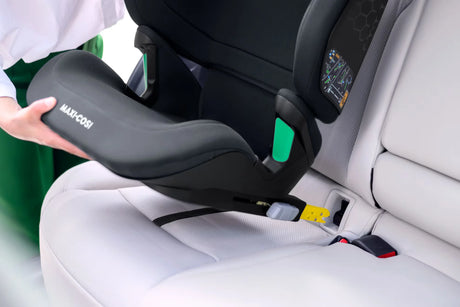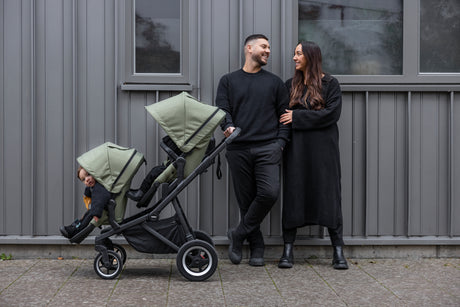Remember the thrill and freedom of riding your bike for the first time? For many of us, it’s a cherished childhood memory, and now it’s your turn to pass on this joyful milestone. Teaching your child how to ride a bike is not just about physical activity, it’s about building confidence, learning safety, and enjoying outdoor fun together. The process of teaching your child to master two wheels can be as rewarding for you as it is for them.
In this guide, we’ll walk through some essential tips to make learning to ride a bike a smooth and enjoyable experience for both of you. From choosing the right bike to mastering the art of pedalling and stopping, each step is crucial in building a solid foundation for your young cyclist. We'll also explore engaging teaching techniques that make learning fun, such as turning practice sessions into interactive games and encouraging regular practice. Whether it's your child's first time on a bike or they're transitioning from training wheels, this guide provides all the tips and tricks to ensure a smooth ride. Get ready to create some wonderful new memories together as you set off on this journey.
1. Choose the Right Bike
Choosing the right bike is crucial when teaching a child how to ride. The key is to find a bike that is the appropriate size for the child. They should be able to sit comfortably on the seat with both feet flat on the ground. This setup provides necessary stability and builds confidence, as it allows the child to feel secure, knowing they can easily touch the ground and steady themselves if they feel unstable.
Moreover, involving the child in the selection process of the bike can greatly enhance their eagerness to learn.
Allowing them to pick the color or style that appeals to them fosters a sense of ownership and excitement. A child who loves their bike is more likely to be enthusiastic about riding it regularly, turning each practice session into a joyful experience. This emotional investment is an often-overlooked aspect of making the learning process smoother and more enjoyable.
2. Adjust the Bike Setup

Adjusting the bike setup is a fundamental step in preparing your child for their first riding experience. Lowering the seat of the bike is essential, as it allows the child to sit with their knees slightly bent while keeping their feet flat on the ground. This particular setup is crucial because it offers the child better control and stability while they are learning. With their feet readily able to touch the ground, children can quickly stabilize themselves if they start to wobble or feel like they are going to fall, which significantly reduces the likelihood of accidents.
This simple adjustment not only enhances their ability to balance but also boosts their confidence, as they feel more secure on the bike. Ensuring that your child can comfortably and easily manage their balance is instrumental in providing a positive and encouraging learning environment.
3. Safety Gear
Before a child begins their journey into bike riding, equipping them with the appropriate safety gear is imperative. The most crucial piece of safety equipment is the helmet. A properly fitted helmet protects the child’s head, significantly reducing the risk of serious injuries in case of falls or collisions. Alongside the helmet, knee and elbow pads should be considered as additional layers of protection. These pads help prevent scrapes and bruises, which are common when children are learning to ride.
Starting with these safety measures instils a habit of prioritizing safety from a young age. This early adoption of safety gear as a non-negotiable part of riding teaches children the importance of protective measures, fostering a mindset that values safety as they grow and engage in other activities. Moreover, knowing they are protected can also make the learning process less intimidating for the child, and more reassuring for the parents, promoting a more relaxed and focused learning environment.
4. Start with Basics
Before pedaling even begins, it's important that the child learns fundamental skills such as how to properly get on and off the bike, effectively use the brakes, and confidently handle steering. These foundational abilities ensure safety and ease as they progress to more complex riding skills. Practicing these basics can be done on a stationary bike to minimize initial challenges and distractions. This controlled environment allows the child to focus on mastering each movement without the added complexity of maintaining balance.
Additionally, teaching the child to maintain a relaxed grip on the handlebars is crucial. A tight grip can make the bike feel jittery and less controllable, leading to nervousness and instability. Emphasizing a light, yet firm hold helps the child steer more smoothly and enhances their overall control of the bike, setting a positive tone for the learning process.
5. Use a Balance Bike or Remove Pedals
Introducing a child to bike riding can be greatly simplified by using a balance bike or by removing the pedals from a standard bike. Balance bikes are designed without pedals, enabling young riders to focus solely on one of the most crucial skills in cycling: balancing. Children can push the bike with their feet, allowing them to gain momentum and learn to balance naturally as they start to lift their feet and glide. This method builds their confidence and understanding of the fundamental mechanics of biking without the added complexity of pedaling.
Alternatively, if a balance bike is not available, removing the pedals from a regular bike can achieve a similar effect. This allows the child to concentrate on mastering balance by using their feet to stabilize and propel themselves forward. Both methods help the child develop a strong foundation in balance before introducing more complex biking skills, making the transition to a full bike much smoother.
6. Practise Gliding and Balancing
Once a child has grasped the basics of balancing, the next step in learning to ride a bike is practicing gliding. This involves encouraging the child to lift their feet off the ground and glide smoothly. Gliding helps reinforce balance skills and builds confidence in their ability to handle the bike without the need for continuous support from their feet. It’s an exhilarating step forward that feels like real biking to a young learner.
A great way to practice gliding is by finding a gentle slope. The slight incline allows the bike to gain a little momentum, making it easier for the child to maintain balance without pedaling. As they coast down, they learn to control the bike at speed, which is a crucial skill for biking on varied terrains. This not only enhances their balancing capabilities but also prepares them for more advanced cycling activities, ensuring they feel secure and excited about their progress.
7. Introduce Pedals
Once your child has mastered balancing and gliding on their bike, it’s time to introduce pedals. This is an exciting progression in their learning journey. Start by securely reattaching the pedals to their bike. Initially, you may need to support the bike as they get the hang of pedaling. Encourage them to pedal slowly at first, maintaining balance while they adjust to the new motion. As they become more comfortable and their confidence grows, gradually reduce the support you provide, allowing them the freedom to pedal independently.
If you are interested in enhancing your child's balance before this step, consider the "towel hack," which involves using a towel for stability training. This technique is especially useful for younger children. If you want to find out more about how to use the towel hack, click here. (Interlink with common mistakes article)
8. Teach Stopping
Teaching a child how to stop safely is as important as teaching them how to ride. Before letting them ride freely, it's crucial to ensure that they understand how to use the brakes properly. This skill is fundamental to their safety and confidence on the bike. Begin by explaining how the brakes work and the importance of using them gently to avoid abrupt and potentially dangerous stops.
Practicing stopping should be done in a controlled environment, such as a flat, open area free from obstacles. Encourage the child to start pedaling slowly, then apply the brakes softly to come to a gradual stop. Repeat this exercise, gradually increasing the speed as they become more comfortable with the braking process. This practice helps them develop a feel for how much pressure to apply to the brakes in different situations, ensuring they can stop safely and effectively when needed.
9. Practise Regularly and Stay Positive

Consistency is crucial when teaching a child to ride a bike. Opt for regular, short practice sessions, which are more effective than longer ones. These frequent, focused intervals help reinforce skills and build confidence gradually. Always provide plenty of encouragement, maintain a light and fun atmosphere, and celebrate each small victory. Such positive reinforcement keeps their spirits high and motivation strong, making the learning process enjoyable and rewarding for both of you.
10. Interactive Learning
Interactive learning techniques can significantly enhance the bike-riding experience for children by making the process both fun and educational. Transforming practice sessions into games such as "Follow the Leader" not only engages a child’s attention but also subtly boosts their bike handling skills. For example, by following someone else's path, children learn to steer and control their bike in a playful setting. Additionally, drawing paths or tracks with chalk provides visual guidance and helps them practice steering and staying within boundaries.
Setting up surprise obstacle courses is another exciting way to develop their skills. These courses can include cones to weave through or small ramps to navigate, which encourage precision and improve balance. Each of these activities helps to break the monotony of learning and infuses a sense of adventure and achievement in the child. By turning learning into an interactive game, children become more enthusiastic about practicing and mastering the art of biking.
11. Incentivize Progress
Incentivizing progress is a powerful method to keep children motivated while learning to ride a bike. Offering small rewards for achieving specific goals, such as stickers for daily practice or a special treat for mastering a new skill, adds an element of excitement to the process. These rewards not only acknowledge their efforts but also encourage continued enthusiasm and commitment.
12. Join Them
Joining your child on bike rides not only makes the learning process more enjoyable but also provides practical demonstrations of cycling skills. Riding alongside them allows you to model proper techniques and safety habits firsthand. This shared activity can strengthen your bond and boost their confidence, as they see biking as a fun and communal activity rather than a solo challenge. It’s a wonderful way to encourage a lifelong love for cycling.
Learning to bike In a nutshell
As we wrap up our guide to teaching your child to ride a bike, remember that patience and encouragement are your best tools. Every child learns at their own pace, and each small victory is a step towards their independence on two wheels. Cycling is not just about physical activity, it's also a great way to boost confidence, enjoy the outdoors, and create lasting memories together.
We hope these tips have equipped you with the knowledge to guide your child through the exciting stages of learning to ride a bike. From choosing the right bike to mastering the fine art of balancing and pedaling, each phase brings its own joys and challenges. As you continue this journey, keep the sessions light-hearted and fun, and don't forget to celebrate every success, no matter how small.
For more engaging content and helpful tips, or to share your own biking adventures, follow us on social media. We love seeing your success stories and hearing how our advice has helped your little ones flourish on their bikes.
Happy cycling!






